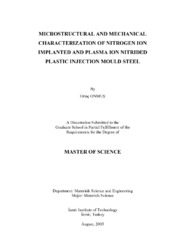Please use this identifier to cite or link to this item:
https://hdl.handle.net/11147/3791| Title: | Microstructural and mechanical characterization of nitrogen ion implanted and plasma ion nitrided plastic injection mould steel | Authors: | Onmuş, Ortaç | Advisors: | Öztürk, Orhan | Publisher: | Izmir Institute of Technology | Abstract: | In this study, high-chromium ferritic plastic injection mould steel (X36CrMo17, similar to AISI-420F) was subjected to plasma nitriding and nitrogen ion beam implantation under various conditions. The effectiveness of conventional plasma nitriding and nitrogen ion beam implantation conditions in improving the tribological properties and mechanical performance was investigated.The experimental results clearly show that plasma nitriding and nitrogen ion beam implantation lead to the development of the various near-surface microstructures and enhanced mechanical properties.Plasma nitriding was performed at a temperature range between 520-540 °C, with a bias voltage of 500 V for 15 to 18 hours under various gas mixtures of N2+H2 in an industrial nitriding facility (micro-pulsed DC). Nitrogen ion beam implantation was carried out with 2x1017 and 1x1018 ion doses with an 85 kV nitrogen ion energy at temperatures 200 a1C. Near-surface phases, compositions, plasma nitrided and nitrogen implanted layer thicknesses and the strength of these layers were studied by a combination of symmetric (0-2.) and grazing incidence x-ray diffraction (XRD and GIXRD), conversion electron and x-ray Mössbauer spectroscopies (CEMS and CXMS), cross-sectional scanning electron microscopy (SEM) and cross-sectional nanohardness measurements. The corrosion behaviour was investigated by a salt spray method and by observation of acid etching during SEM sample preparation. The tribological properties (friction and wear) were examined by a ball-on-disc tribometer.Combined Mössbauer, XRD, and SEM analyses clearly indicate that (Fe,Cr,Mn)-nitrides and CrN are distributed in the top nitrided layers of several micron thickness. The CEMS and CXMS analyses show the nearly complete decomposition of the near surface and deeper crystal structures into pure bcc (Fe), (Fe,Cr,Mn)-nitrides, consisting of Fe3N and Fe4N, and CrN. The XRD, CEMS and CXMS results also show an Fe3C-like carbide phase, (Fe,Cr,Mn)3C, in the nitrided layers, whose presence is attributed to C segregation to the near-surface region and to extra carbon being present in the nitriding system. The nitriding conditions with the gas composition N2/H2.1 produces the thickest nitrided layer (about 135 .m) with an excellent resistance to corrosion. The nanohardness measurements indicate that the cross sectional hardness-depth profiles under all nitriding conditions is found to be plateau-shaped, and the nitrided layer surface hardness values are found to be increased by a factor of about three in comparison to that of the substrate material. This study also showed that the hardening effect in plasma nitrided specimens was due to a fine and homogeneous chromium nitride precipitation. The wear analysis results showed that the nitrided layers have reduced friction coefficient values (20 to 25%) and possess excellent wear resistance in comparison to that of the bulk material.It was also found that nitrogen ion implantation into plastic injection mould steel produces N content rich layers (less than 0.1 .m thick) with enhanced wear and corrosion properties. The surface nanohardness measurements of the low and high dose implanted specimens indicate that the hardness values increase by factors of about 1.4 and 1.6, respectively, compared to the substrate material. The salt spray corrosion analysis (2% NaCl solution in distilled water) experiments showed enhanced corrosion behaviour for the N implanted layers, and that nitrogen ion implantation is a viable method for improving corrosion resistance of plastic injection mould steel.Combined Mössbauer and XRD data reveal that the N implanted layers consist of nitride phase, (Fe,Cr,Mn)2+xN, with both magnetic (x-1) and paramagnetic (x-0) characteristics. Based on the CEMS results, the N implanted layer thicknesses are found to be - 40 and 65 nm for the low dose (2x1017 ions/cm2) and high dose (1x1018 ions/cm2) dose N implanted specimens, respectively. | Description: | Thesis (Master)--Izmir Institute of Technology, Materials Science and Engineering, Izmir, 2003 Includes bibliographical references (leaves: 71-76) Text in English; Abstract: Turkish and English xii, 76 leaves |
URI: | http://hdl.handle.net/11147/3791 |
| Appears in Collections: | Master Degree / Yüksek Lisans Tezleri |
Files in This Item:
| File | Description | Size | Format | |
|---|---|---|---|---|
| T000273.pdf | MasterThesis | 3.43 MB | Adobe PDF |  View/Open |
CORE Recommender
Page view(s)
178
checked on Nov 18, 2024
Download(s)
64
checked on Nov 18, 2024
Google ScholarTM
Check
Items in GCRIS Repository are protected by copyright, with all rights reserved, unless otherwise indicated.